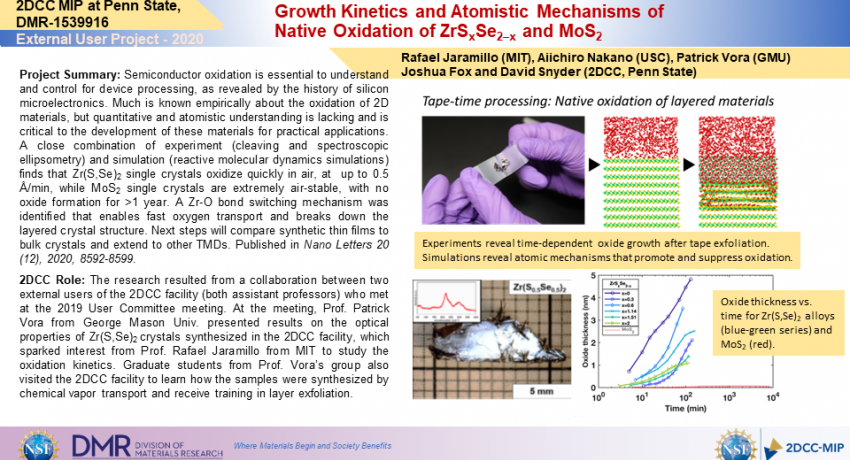What Has Been Achieved:
Quantitative experimental study of the rate of native oxidation of transition metal dichalcogenides: MoS2 and of a family of Zr(S,Se)2 alloys. Theoretical study illuminating the atomistic basis for the extreme difference between non-oxidation of MoS2 and rapid oxidation of Zr(S,Se)2.
Importance of the Achievement:
Detailed and predictive understanding of native oxidation is essential for developing semiconductor technology. Here we adapt an approach that’s tried-and-true for silicon for use with new and emerging 2D materials. Our experimental results offer specific guidance to researchers making semiconductor devices from MoS2 and Zr(S,Se)2. Our theoretical results explain our experimental findings in graphic detail, including the discovery of a mechanism, not previously reported, of Zr-O bond switching and oxy-sulfide intermediate phase formation.
Unique Feature(s) of the MIP that Enabled this Achievement:
2DCC-MIP’s synthesis of large single crystals of sulfide-selenide alloys.
Publication:
Jo, S. S., Singh, A., Yang, L., Tiwari, S. C., Hong, S., Krishnamoorthy, A., Sales, M. G., Oliver, S. M., Fox, J., Cavalero, R. L., Snyder, D. W., Vora, P. M., McDonnell, S. J., Vashishta, P., Kalia, R. K., Nakano, A. & Jaramillo, R. Growth Kinetics and Atomistic Mechanisms of Native Oxidation of ZrSxSe2–x and MoS2 Crystals. Nano Lett. (2020). DOI:10.1021/acs.nanolett.0c03263
This work was supported by an Office of Naval Research MURI through grant N00014-17-1-2661. This work was supported by a start-up grant from the Indian Institute of Science. We acknowledge the use of facilities and instrumentation supported by NSF through the Massachusetts Institute of Technology (MIT) Materials Research Science and Engineering Center DMR 1419807. This material is based upon work sponsored in part by the U.S. Army Research Office through the Institute for Soldier Nanotechnologies, under contract
W911NF-13-D-0001. The work at USC was supported as part of the Computational Materials Sciences Program funded by the U.S. Department of Energy, Office of Science, Basic Energy Sciences, under Award DE-SC0014607. We would also like to thank USC Advanced Research Computing, and the Argonne Leadership Computing Facility under the DOE INCITE and Aurora Early Science programs. The work was financially supported by the National Science Foundation (NSF) through the Pennsylvania State University 2D Crystal Consortium Materials Innovation Platform (2DCC-MIP) under NSF cooperative agreement DMR-1539916. P.M.V. and S.M.O. acknowledge support from the George Mason University Quantum Science and Engineering Center, Presidential Scholars Program, and from the NSF through Grant 1847782. We acknowledge assistance from the Department of Mineral Sciences, Smithsonian Institution. M.G.S. acknowledges support through the William L. Ballard Jr. Endowed Graduate Fellowship.
Credits/Names: Rafael Jaramillo (MIT), Aiichiro Nakano (USC), Patrick Vora (GMU) Joshua Fox and David Snyder (2DCC, Penn State)
Download PDF Version: 1539916_2DCCMIP_2020_GrowthKineticsAndAtomosticMchanismsOfNativeOxidationZrSxSe2-xAndMoS2.pdf
Year of Research Highlight: 2020
Select a Highlight Type: Broader Impact Highlight
